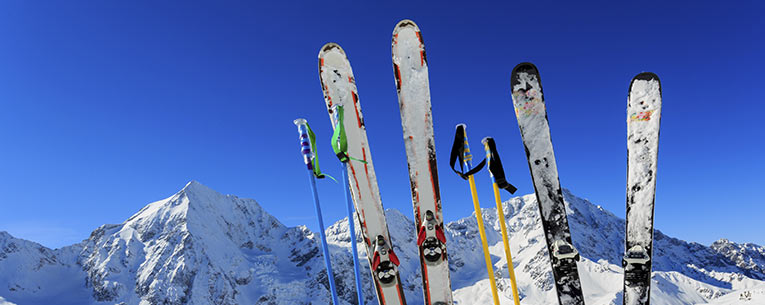The time has finally come to head out on your ski trip, and if you've ever embarked on a long-distance trip to hit the slopes before, you know flying with your gear can prove difficult. Fortunately, it doesn't have to be this way. Knowing a few steadfast rules can go a long way, and with these tips, you can remove many of your ski travel headaches.
Protect Your Gear
A little forethought when traveling with your gear can go a long way. Don't take the cheap route when purchasing a ski bag.1 At a minimum, you should be using a dual-padded ski bag. Make sure to pack your ski poles in the same bag as well. If you don't, this might result in additional checked baggage fees.
Always keep in mind that bags with extra padding might not fit as easily on standard ski racks you have on your vehicle. So if you have to drive to the airport, you may want to wait until you're parked to load your gear in the padded bag.
Get the Most Out of Your Space
Whenever you're checking baggage with your airline, you'll very likely encounter a 50-pound weight limit. Anything over this weight could result in additional charges. Fortunately, your skis likely don't hit this threshold. With that in mind, fill your ski bag up as much as possible. Toss gloves, hats, socks or any other soft items that won't damage your skis in there.
However, make sure that you don't get overzealous and load your boot bag up as well. You're only allowed to have your boots stored in these bags. Don't worry about paying extra for transporting them: As long as it's checked along with your skis, the boot bag doesn't count as a piece of checked luggage.2
Know Airline Rules for Ski Equipment
Unfortunately, there aren't many clearly defined rules when it comes to flying on different carriers. On American Airlines3, for instance, you might face oversize fees if your skis are longer than 126 inches.
If you're flying Air Canada4, however, you'll experience no oversize charges related to length. With these savings, you could get travel insurance to protect your entire trip. The same is true if you're flying on Frontier5, but if your boot bag is over 25 pounds, you'll be charged for an additional checked bag.
For ski equipment, Delta6 allows luggage to exceed 80 inches. Then again, Southwest7 will count two bags with ski equipment, such as your boots, poles or skis, as a single item. This is true even if they're tagged separately!
Consider Rental Equipment
International travel insurance can protect you if any emergencies rear their ugly head, but if you think that your favorite pair of skis is irreplaceable, why not consider leaving them at home? They're at much greater risk when flying around the world, and ski destinations across the globe have companies that rent out the exact equipment you'll need.
Whether you're traveling international or domestic, you might be able to get an even better deal when renting equipment. Many resorts and hotels offer discounted or free rentals if you book with them. This means a few more minutes researching where you'll stay, but it's well worth the time in the end.
Get Your Baggage Fees Waived
On Delta, your first checked bag will be free. On Southwest, you get two free checked bags. If this isn't enough to avoid baggage fees, or if you fly on a different carrier, you can check with hotels to see if they'll reimburse you for your luggage fees. These are often listed as "checked bag credits," and they'll simply provide a discount on the cost of the hotel to make up for baggage fees.
Consider Shipping Your Gear
A method of traveling with ski gear that's quickly gaining popularity is simply shipping everything. There are some companies that will package and ship your stuff for free, but you could save money by doing it yourself.
In fact, the shipping quotes for a pair of skis drops as low as $39 at some national retailers.8 Of course, you'll want to make sure you know a thing or two about packaging. If not, it's better to have professionals ship everything directly to your hotel. You'll be able to skip the baggage counter at the airport and the crowded carousel at your destination.
While purchasing travel insurance secures your trip, the vacation can still be ruined if something goes wrong with transporting your equipment. One mistake on your or the airline's part could end your awesome vacation as nothing more than a bad taste in your mouth. By considering the aforementioned tips, though, you're helping to avoid these eventualities.









Share this Page